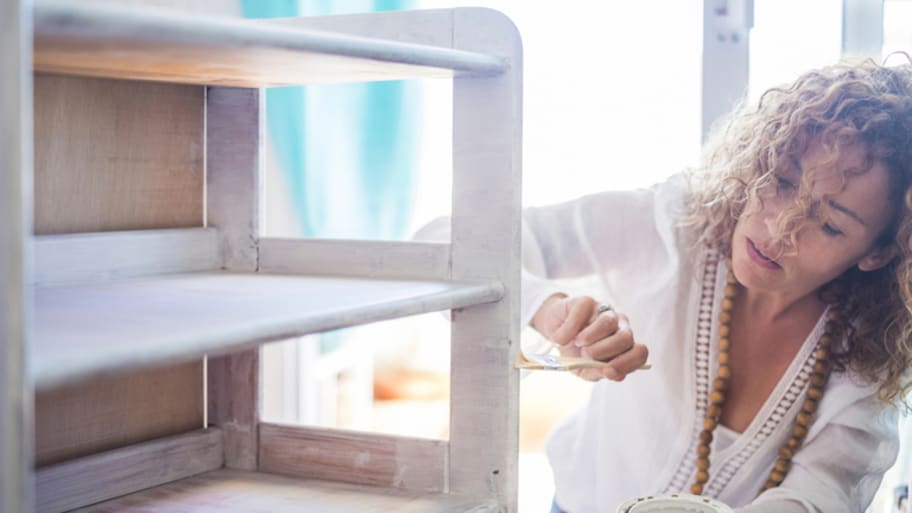Milk paint and chalk paint are both decorative finishes that will give your DIY a distressed look, but they contain different ingredients with slightly different textures
Milk paint and chalk paint are so similar that some crafters can’t even tell the difference between the two. Both have unique textures, a matte-like finish, and a quick drying time. But when you apply the two paints side by side, you’ll notice that they create different looks.
Milk Paint Pros and Cons
Milk paint is fun to work with and will give your DIY a unique, distressed look, but it does come with a few important caveats.
Milk Paint Pros
Eco-friendly and non-toxic
Long-lasting
Creates distressed look
Milk Paint Cons
Lumpy consistency (needs power mixing)
Short shelf life
Unpredictable finish
For thousands of years, people have cherished milk paint for its longevity, richness, and natural look. It’s a nontoxic water-based paint that typically contains milk, lime, and sometimes added pigments for color (though pigments are usually separate). Borax is also sometimes mixed in to help preserve the paint.
Because it’s made from natural ingredients, milk paint is a safe and eco-friendly paint option. But unfortunately, organic ingredients spoil quickly. Most milk paints will only last a day or two, though those with added preservatives can last up to two weeks. Pop it in your refrigerator to help it last longer. Since it’s natural, you won’t need to worry about it releasing toxins and contaminating your groceries. That said, put it in your garage fridge if you have one in case the paint spills—even though it’s natural, it probably doesn’t taste great
You can usually purchase dry, powdered pigments and liquid base paint separately, which allows you to create one-of-a-kind colors by changing the amount of pigment you add or even mixing different ones. Milk paint is fully customizable. And unless it’s constantly battered by the elements, milk paint can last hundreds of years.
If you’re aiming for a very specific look with your project, you may get frustrated. Milk paint can be lumpy, especially if you mix it by hand, because of undissolved powdered pigment. The lumps of pigment can create streaks when you apply it. If you want a solid look, you’ll need to power mix the paint with a special drill attachment you can buy from your local home improvement store.
Its lumpy texture can also affect how the paint dries, with finishes sometimes sloughing off in a fine powder and other times chipping away in larger chunks.
Chalk Paint
If you’re reviving your childhood dresser so that it looks fresh and up-to-date, paint it with chalk paint. Compared to milk paint, it offers a more consistent finish. But you must apply it properly to keep everything looking even.
Chalk Paint Pros
Comes pre-mixed
Consistent matte look
No primer needed
Chalk Paint Cons
Expensive
No custom colors
Leaves brush marks
Renowned industry expert Annie Sloan coined the term “chalk paint” in the 1990s. It’s a thicker paint made with calcium carbonate, talc, and pigment. The Annie Sloan brand of chalk paint is relatively expensive compared to milk paint brands, so the price of your DIY will go up if you choose to use chalk paint.
However, you will be able to cut costs on other supplies. Chalk paint is sticky and adheres to surfaces easily, so you won’t need to coat your DIY with primer beforehand. That eliminates one item from your supply list and makes the process quicker.
Put down the power mixer—chalk paint comes pre-mixed in standard quart paint cans, so you’ll just need to stir it by hand before applying it. But pre-mixed paint has its disadvantages, too. Unlike milk paint, chalk paint isn’t easily customizable. The pigment is already mixed into the base paint, which means you can’t create paints with your own custom color scheme.
Chalk paint is thick and can leave visible brush marks if you don’t paint it on properly. Avoid this by thinning the paint with water beforehand and painting with a wet brush. The brush strokes should disappear with the more coats you do. But if you’re aiming for a more rough-around-the-edges look, stick to one or two coats for a light wash.

How to Use Milk Paint In Your Home
Repainting your kitchen cabinets to fit a vintage farmhouse vibe? Choose milk paint. While it can be unpredictable and you’ll have to mix it manually, it will always finish with a distressed look. It can turn any furniture piece into a shabby chic, antique-looking masterpiece.
Apply it with a brush, roller, or sprayer. Add more coats as necessary to get your desired look. Some people prefer only one coat, while others go for three or four. If adding multiple coats, let the first coat dry completely before moving on.
Milk paint, like chalk paint, doesn’t require a primer. And you won’t have to worry about sanding your furniture down before painting it with milk paint, either, though you’re always welcome to sand down rough patches on your furniture before painting for a smoother surface. It also dries quickly, so your DIY project won’t suck up all of your precious time.
How to Use Chalk Paint In Your Home
Chalk paint is ideal for refreshing outdated furniture pieces or even coating metallic accents like old lamps. It dries to a flat, chalky texture that lends well to vintage-looking pieces.
Not only does chalk paint look great as an antiquing finish, but it can also create a modern, smooth texture. To achieve this look, you’ll need to use fine-grit sandpaper to sand down multiple layers. The sanding process helps create a soft, smooth surface.
You can also apply milk paint with either a brush, roller, or sprayer. Sprayers and rollers may create more seamless looks, while painting with a brush can make the piece look more worn (in a good way). Chalk paint takes little time to dry and won’t require the use of a primer, so it’s an excellent choice for DIYers without a lot of time on their hands.
Whether you choose milk paint or chalk paint for your project, you’ll end up with a beautiful, distressed piece that will turn heads. Their characteristics are similar, but not identical. Consider the factors above before making your choice.




